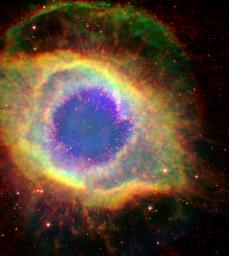Six hundred and fifty light-years away in the constellation Aquarius, a dead star about the size of Earth, is refusing to fade away peacefully. In death, it is spewing out massive amounts of hot gas and intense ultraviolet radiation, creating a spectacular object called a "planetary nebula."
In this false-color image, NASA's Hubble and Spitzer Space Telescopes have teamed up to capture the complex structure of the object, called the Helix nebula, in unprecedented detail. The composite picture is made up of visible data from Hubble and infrared data from Spitzer.
The dead star, called a white dwarf, can be seen at the center of the image as a white dot. All of the colorful gaseous material seen in the image was once part of the central star, but was lost in the death throes of the star on its way to becoming a white dwarf. The intense ultraviolet radiation being released by the white dwarf is heating and destabilizing the molecules in its surrounding environment, starting from the inside out.
Like an electric stovetop slowly heating up from the center first, the hottest and most unstable gas molecules can be seen at the center of the nebula as wisps of blue. The transition to more stable and cooler molecules is clearly depicted as the color of the gas changes from very hot (blue) to hot (yellow) and warm (red).
A striking feature of the Helix, first revealed by ground-based images, is its collection of thousands of filamentary structures, or strands of gas. In this image the filaments can be seen under the transparent blue gas as red lines radiating out from the center. Astronomers believe that the molecules in these filaments are able to stay cooler and more stable because dense clumps of materials are shielding them from ultraviolet radiation.
This image is a composite showing ionized H-alpha (green) and O III (blue) gases from the Hubble Space Telescope, and molecular hydrogen (red) from Spitzer observations at 4.5 and 8.0 microns.

 Planetary Data System
Planetary Data System












